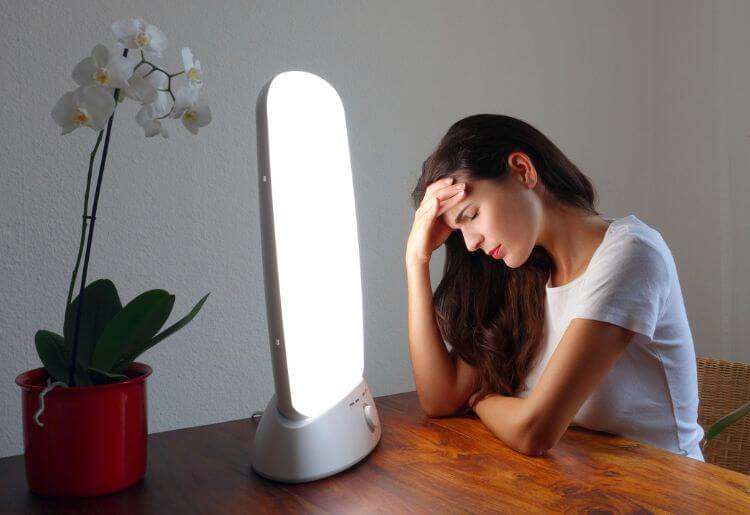For a portion of the population, winter also spells the onset of Seasonally Affective Disorder (SAD), which especially affects those living furthest from the equator, including the northern United States and Canada, the United Kingdom, and northern Europe.
What is SAD?
SAD is a mood disorder characterized by reduced energy, an increased desire to sleep, overeating, and other classic symptoms of major depressive disorder, such as feelings of hopelessness or worthlessness, loss of interest in activities, withdrawal from social activities, and thoughts of suicide.
While the exact causes of SAD are unknown, it is generally accepted that reduced sunlight hours is the main culprit. It is theorized that, with less sunlight, your biological clock, serotonin levels, and melatonin levels may all suffer, resulting in depression or depressive-like symptoms.
If you or a person you know is in danger of harm, call 1-800-273-8255 in the US or your national mental health hotline. If you are unsure of whom to contact, call the police (911 in the US, 112 in Europe).
Whether your symptoms are mild or severe, there are steps you can take to help improve your quality of life during winter, and we explore some below.
1. Get a SAD lamp
SAD lamps are designed to simulate sunlight, with the goal of replacing some of the sunlight lost to axial tilt, which is the tilt of the Earth that causes the sun to shine on different latitudes at different angles. Studies have shown that they’re effective in reducing symptoms of SAD and equally as effective as drugs like Prozak. They’re especially effective for milder cases of SAD, although they can be paired with other treatments to combat more serious symptoms.
Starting at around $45, SAD lamps are relatively affordable and they’re also easy to operate - making them an ideal starting point for treating wintertime depression.

2. Prioritize time outdoors
While SAD lamps are effective, there’s no substitute for natural sunlight. With energy down, SAD can cause people to stay indoors. In northern areas, where SAD is most prevalent, the searing cold doesn’t make it any easier to get off the couch and go outside. However, it’s well worth spending time outdoors for your mental health. Exposure to natural sunlight is crucial for maintaining proper circadian rhythms and it also enables your body to produce Vitamin D. While evidence is mixed on the link between Vitamin D deficiency and poor mental health, its role in maintaining overall health is without question.
In addition to extra time in the sunlight, spending time outdoors, and especially spending time in nature, has been linked to increased cognitive function, reduced stress, and improved overall mental health.
3. Exercise regularly
The relation between exercise and good mental health is complex but undeniable. A wide variety of scientific evidence confirms that exercise improves mood, helps stabilize symptoms of depression and anxiety, and is one of the most beneficial things you can do for your body and mind, all year round.
With winter weather and SAD symptoms, it can be all too easy to stay at home in a lethargic state. But exercising is one of the most powerful and effective weapons in your arsenal to combat seasonal depression. Exercising outdoors is a great way to combine these benefits with additional sunlight, and doing so with others adds the benefits of socializing, too.
4. Optimize your diet for mood
It’s common for people with SAD to crave carb-heavy, sugary, or high-fat foods during the winter. Plus, in general, in most parts of the world, winter foods tend to be heavier. While comfort food is called that way for a reason, evidence of connection between diet and mood informs better food choices for healthier minds.
There are a variety of foods and diets that can help promote good mental health and physical health, from the vegetable-rich to ketogenic and paleo diets. If you’re struggling to find a balanced, healthy diet, consider a meal kit delivery service, many of which cater to special dietary needs and ensure you get a healthy mix of vegetables, protein, carbs, vitamins, and minerals.

5. Make sure your general health is in check
Now is not the time to let your general physical health slip. Winter usually brings about more colds, flu, and general ailments, as people congregate and spend more time indoors. Make an appointment with your doctor (or take advantage of the convenience of an online doctor service) at the start of the winter season for a general consultation. If possible, ask for a blood workup to make sure that.
The last thing you want to have to deal with, in addition to symptoms of depression or anxiety, is physical illness. Plus, certain vitamin deficiencies, like Vitamin B12, can have an impact on mood. While being physically healthy isn’t a cure for mental illness, being sick definitely can wreak havoc on your mental health.
6. Volunteer
You really can help yourself by helping others. Evidence suggests that volunteering can help improve mental health, especially for individuals who have trouble socializing (which is par for course with SAD). Volunteering also serves to get you out of the house, which w can contribute to improved mental health.
Volunteering holds particularly strong benefits for older individuals. If you suffer from SAD or general winter blues and are over the age of 65, this might be an effective way to overcome depression. Volunteering can promote socialization, a sense of community, and feelings of gratitude, all of which contribute to strong mental health.
7. Keep to a regular sleep schedule
A regular sleep schedule is one of the most important factors for maintaining good mental health. Unfortunately, changes in the times of sunset and sunrise, reduced sunlight, and cold weather can all have a big impact on your sleep schedule.
If you experience SAD or general winter blues, do your best to stick to a regular sleep schedule. Importantly, avoid sleeping in too late. This is a common symptom of SAD, but as a general rule, adults need 8 hours of sleep on a consistent basis - more than that is usually of little benefit.
Aim to go to bed and wake up at the same time each day. Getting 7 to 8 hours of sleep is important, but inconsistent bedtime defeats the remedial power of sleep for your mental health.

8. Stay away from screens before bedtime
Avoid screens one to two hours before bed. Blue light from screens can throw off your circadian rhythm, which is already fragile as a result of the reduced sunlight.
Ditch your phone, computer, TV screen or tablet. Instead, try winding down by reading a book. If you need to feel productive in your downtime, opt for podcasts or audiobooks to nurture personal and professional development . Of course, listening to music is another great way to lull yourself to sleep.
9. Practice meditation
Meditation has been shown to reduce stress, ease symptoms of anxiety and depression, promote emotional wellbeing, mitigate against age-related mental deterioration, and improve sleep.
Mindfulness, a form of meditation achieved by focusing on the present moment and acknowledging passing thoughts, bodily sensations and feelings. This style of meditation has been shown to carry significant mental health benefits.
You can practice meditation year round, but it may be particularly useful to you in the wintertime if you suffer from seasonal depression or generally poor mental health. There are a slew of free meditation apps to help you practice mindfulness, gratitude, and more.
10. Speak to a licensed counselor
Speaking to a licensed counselor is the most effective and impactful solution for dealing with SAD, depression, and anxiety, or any other mental health problems you may be experiencing—during winter or any other time of the year. A licensed counselor can assess your symptoms, provide a diagnosis and, most importantly, devise a course of treatment for genuine relief.
Many online therapy providers offer matching services to help you get counsel from the right therapist for your needs. While there are some differences between online and in-person therapy, the former has been shown to be just as effective as the latter for a variety of mental health issues, including SAD, depression, and anxiety.
Actionable Steps to Beat the Winter Blues
It’s not uncommon to feel less energetic or experience mild, short-lived mood changes during winter. But if you struggle with sleepiness, poor concentration, feelings of sadness or anxiety, you may be experiencing symptoms of seasonal affective disorder or SAD.
There are constructive ways to mitigate these symptoms, including light therapy, spending time outdoors, exercising or volunteering, and making sure your sleep schedule and general health are in order. The most effective solution, however, is to speak with a licensed therapist who can provide a diagnosis and personalized course of treatment to help you start feeling better, all winter long.

